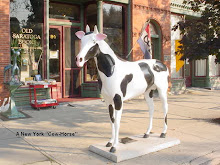This post was written by:
admin - who has written 24356 posts on NewsBag
Posted on 21 February 2010
The meat industry is up in arms over a federal decision to abandon a $120 million livestock-tracking system designed to limit the economic and human-health impact of animal-disease outbreaks.
Meatpackers worry that a narrower program proposed by Agriculture Secretary Tom Vilsack could exacerbate worries abroad about U.S. meat exports, while state officials are concerned the federal government is creating a new regulatory burden for which states have scant resources.
“It will be a headache,” said Tony Frazier, state veterinarian of Alabama.
But federal officials say the six-year-old voluntary program being replaced never attracted enough participation from farmers and ranchers to be effective.
Animal-health experts have long argued a national livestock-identification is essential for rapidly containing livestock diseases. Outbreaks across the globe of mad-cow disease, bird flu and foot-and-mouth disease have cost farmers billions of dollars since the 1990s. In the U.S., beef exports have never fully recovered from a case of mad-cow disease in 2003.
Launched shortly after that scare, the National Animal Identification System was designed to allow Washington to track the far-flung movements of tens of millions of cattle and hogs—among other animals—using 15-digit serial numbers, electronic ear tags and tiny transponders implanted beneath the animals’ hide.
Regulators hoped the high-tech livestock IDs would make it possible for them to locate the farm from which a sick animal came within 48 hours, instead of the weeks or even months it can take now. Such a rapid trace would allow regulators to quarantine exposed herd mates so they can’t infect others or be eaten and pose a threat to people. Australia, Canada, Japan and the European Union have mandatory livestock ID programs.
NAIS was supported by many large producers of milk, chickens and hogs, as well as meatpackers stung in the 2003 mad-cow scare. But many beef ranchers and small farmers spurned the voluntary program over everything from privacy to religious issues, crippling the effort.
Mr. Vilsack said Feb. 5 that he was starting over with a different, mandatory program. Hoping to placate small farmers leery of federal oversight, Mr. Vilsack wants state governments to keep track of livestock—but only those animals moving across state borders.
While many details must be ironed out—including funding—the new approach
exempts animals that are slaughtered in the states where they are raised, even if the meat will go into interstate commerce. Federal officials couldn’t project what percentage of U.S. livestock would fall outside the proposed program.
John Clifford, the USDA’s top veterinarian, said the agency was being practical. “NAIS wasn’t effective,” he said. “That means rebuilding from the grass roots up.”
Many meatpacking executives fear the new system won’t mollify importing countries that are quick to close borders when animal diseases erupt in the U.S. One worry is that identification practices will vary among states, so that tracing back diseased animals will remain cumbersome.
The USDA’s switch “fails to meet the need of meatpackers and their customers to swiftly and accurately trace livestock to the farm of origin,” said Gary Mickelson, a spokesman for meat giant Tyson Foods Inc. of Springdale, Ark.
Some state authorities worry the federal government won’t fully fund the mandate. “At best, this is going to be a patchwork system that takes us back to where we were a decade ago,” said Scott Stuart, managing director of the National Institute for Animal Agriculture, a Colorado Springs, Colo., nonprofit group of livestock interests.
At big slaughterhouses, government veterinarians and meat inspectors routinely check the health of livestock and the wholesomeness of meat. While that helps to protect consumers, the information rarely gets used to extinguish outbreaks among animals. Livestock change hands so frequently that meatpackers often don’t know where they originated.
The lack of a system became an issue in December 2003 when the first U.S. case of mad-cow disease was discovered. Federal regulators were under pressure to find the companions of that Holstein cow, which died in Washington state, because the livestock might have shared rations, the likely source of a brain-wasting disease that can spread to humans who eat infected beef.
Most of the sick cow’s herd mates were never identified, and some 50 nations banned imports of U.S. beef. U.S. beef exports sank by about 80% in 2004.
“We are disappointed by the decision,” said Ron DeHaven, who was the USDA’s chief veterinarian during the mad-cow scare and is now executive vice president of the American Veterinary Medical Association in suburban Chicago. “The ability to trace is only becoming more important to our trading partners.”
The USDA’s national livestock ID system was in trouble early. Agriculture Department officials initially mulled making it mandatory—a concept backed by meatpackers—but backed off in the face of rural backlash against federal imposition.
Many farmers fear being held financially liable if a diseased animal is traced to their doorstep. For just this reason, critics warned a voluntary system wouldn’t attract enough producers to be effective. Only about 500,000 farms and ranches, or 36%, registered with the USDA’s national program, far below the 90% participation rate some federal officials say is needed to make such a system effective.
”It was overly intrusive,” said Bill Bullard, chief executive of R-CALF USA, a group representing thousands of beef ranchers. “It was an effort by the federal government to control our livestock.”
Yet many farmers who participated in the USDA program figured it could help narrow the economic fallout from a disease outbreak by allowing regulators to make quarantines more precise and thus disrupt fewer farm operations, said Dave Warner, a spokesman for the National Pork Producers Council, representing hog farmers.
Federal officials plan to begin meeting with state officials about the new program in March. The USDA aims to publish a proposed rule by the end of 2010.
Click on tite above for original article as appeared in the link below;
http://www.newsbag.org/?p=43418


















